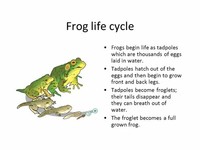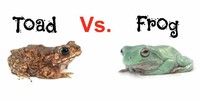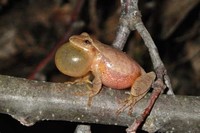Facts about Frog

The alkaloid epibatidine, a painkiller 200 times more potent than morphine, is found in some species of poison dart frogs.

Frogs must be able to move quickly through their environment to catch prey and escape predators, and numerous adaptations help them do so.
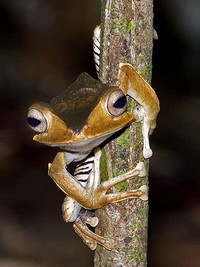
Females of many frog species, for example Polypedates leucomystax, produce calls reciprocal to the males', which act as the catalyst for the enhancement of reproductive activity in a breeding colony (Roy 1997).

Arboreal frogs usually have smooth skin, enabling them to disguise themselves as leaves.

Frogs have a tympanum on each side of the head, which is involved in hearing and, in some species, is covered by skin.

Nocturnal frogs usually find the ideal camouflaged position during the day to sleep.

The male Australian pouched frog (Assa darlingtoni) has pouches along its side in which the tadpoles reside until metamorphosis.

A few of the larger species may eat prey such as small mammals, fish, and smaller frogs.

Culturally, frogs feature prominently in folklore, fairy tales, and popular culture.

The croak of the American bullfrog (Rana catesbiana) is sometimes spelled "jug o' rum."

Frogs often also have what are called vomerine teeth on the roof of their mouth.

Some frogs that live high in trees even possess an elaborate degree of webbing between their toes, as do aquatic frogs.

The skin of a frog is permeable to oxygen and carbon dioxide, as well as to water.

Habitat loss is a significant cause of frog population decline, as are pollutants, climate change, the introduction of non-indigenous predators/competitors, and emerging infectious diseases including chytridiomycosis.

Most temperate species of frogs reproduce between late autumn and early spring.

Almost all species of frogs are carnivorous as adults, eating invertebrates such as arthropods, annelids, and gastropods.

Ground-dwelling frogs generally lack the adaptations of aquatic and arboreal frogs.

Some frogs use their sticky tongues to catch fast-moving prey, while others capture their prey and force it into their mouths with their hands.

Other frogs carry the eggs and tadpoles on their hind legs or back (e.g., the midwife toads).

Another fossil frog, discovered in Arizona and called Prosalirus bitis, was uncovered in 1985, and dates from roughly the same time as Triadobatrachus.
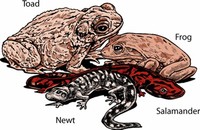
The physiology of frogs is generally like that of other amphibians (and differs from other terrestrial vertebrates) because oxygen can pass through their highly permeable skin.

Some frogs have the ability to change color, but this is usually restricted to shades of one or two colors.

The female tigers generally own territory near their mother, while males tend to wander in search of territory, which they acquire by fighting and eliminating another male.

Other chemicals isolated from the skin of frogs may offer resistance to HIV infection (VanCompernolle et al.

Poisonous frogs tend to advertise their toxicity with bright colors, an adaptive strategy known as aposematism.

has fully webbed toes, whereas the toes of White's tree frog (Litoria caerulea), an arboreal species, are only a half or a quarter webbed.

Future studies of molecular genetics should soon provide further insights to the evolutionary relationships among frog families (Faivovich et al.

Some species of frog will leave a "babysitter" to watch over the frogspawn until it hatches.
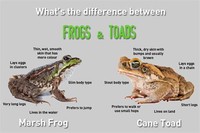
Most of these characteristics are not common between all the families of Archaeobatrachians, or are not absent from all the modern species of frog.

Some frog species are adapted to a cold environment; for instance the wood frog, which lives in the Arctic Circle, buries itself in the ground during winter when much of its body freezes.

The skull is frog-like, being broad with large eye sockets, but the fossil has features diverging from modern amphibians.

Among these species are the golden toad of Costa Rica and the gastric-brooding frogs of Australia.

Features such as warts and skin folds are usually found on ground-dwelling frogs, where a smooth skin would not disguise them effectively.

Frogs range in size from 10 millimeters (Brachycephalus didactylus of Brazil and Eleutherodactylus iberia of Cuba) to 300 millimeters (goliath frog, Conraua goliath, of Cameroon).

Species of frog without vocal sacs and that do not have a loud call tend to inhabit areas close to flowing water.

Eggs hatch and the frogs continue life as tadpoles (occasionally known as polliwogs).

A female generally lays frogspawn, or egg masses containing thousands of eggs, in water.
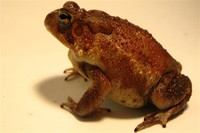
Compared with the other two groups of amphibians (salamanders and caecilians), frogs are unusual because they lack tails as adults and their legs are more suited to jumping than walking.

Dead frogs are sometimes used for dissections in high school and university anatomy classes, often after being injected with colored plastics to enhance the contrast between the organs.

More importantly, reproducing early in the season ensures that appropriate food is available to the developing frogs at the right time.

Many frogs contain mild toxins that make them distasteful to potential predators.
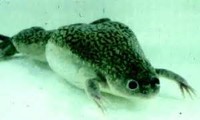
Once adult frogs reach maturity, they will assemble at a water source such as a pond or stream to breed.

The structure of the feet and legs varies greatly among frog species, depending in part on whether they live primarily on the ground, in water, in trees, or in burrows.

Many frogs return to the bodies of water where they were born, often resulting in annual migrations involving thousands of frogs.

The final stage of development from froglet to adult frog involves apoptosis (programmed cell death) and resorption of the tail.

The greatest diversity of frogs occurs in the tropical areas of the world, where water is readily available, suiting frogs' requirements due to their skin.

Most of these frogs have morphological features than are more complex than those of the Mesobatrachians and Archaeobatrachians.

Adult frogs are themselves preyed upon by birds, large fish, snakes, otters, foxes, badgers, coatis, and other animals.

Frogs breathe by taking air in through the nostrils (causing the throat to puff out), and compressing the floor of the mouth, which forces the air into the lungs.

At the end of the tadpole stage, frogs undergo metamorphosis, in which they transition into adult form.

Frogs are usually well-suited to jumping, with long hind legs and elongated ankle bones.

Frogs have served as important model organisms throughout the history of science.

Many frogs are able to absorb water directly through the skin, especially around the pelvic area.

The life cycle of frogs, like that of other amphibians, consists of the main stages of egg, tadpole, metamorphosis, and adult.

The habitat of frogs extends almost worldwide, but they do not occur in Antarctica and are not present on many oceanic islands (Hogan and Hogan 2004).

The earliest true frog is Vieraella herbsti, from the early Jurassic (188–213 million years ago).

The common name of these frogs was thus changed from "poison arrow frog" to "poison dart frog" in the early 1980s.
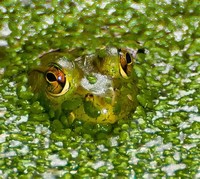
Most camouflaged frogs are nocturnal, which adds to their ability to hide.

Some frogs also look after their eggs—and in some cases even the tadpoles—for some time after laying.

Michigan J. Frog, featured in a Warner Brothers cartoon, only performs his singing and dancing routine for his owner.

The hind legs of ground dwellers are more muscular than those of aqueous and tree-dwelling frogs.
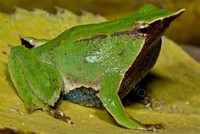
Darwin's frog (Rhinoderma darwinii) from Chile puts the tadpoles in its vocal sac for development.

Many preliterate cultures embraced notions of animism and shamanism postulating early ideas of the soul.

Due to the many morphological features that separate the frogs, there are many different systems for the classification of the anuran suborders.

The Moche people of ancient Peru worshipped animals and often depicted frogs in their art (Berrin and Larco Museum 1997).

The earliest known (proto) frog is Triadobatrachus]] massinoti, from the 250-million-year-old early Triassic of Madagascar.

Some frogs inhabit arid areas such as deserts, where water may not be easily accessible, and rely on specific adaptations to survive.
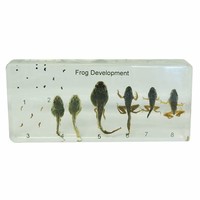
Egg and tadpole development is very fast in comparison to most other frogs so that breeding is complete before the pond dries up.

Some burrowing frogs have a toe extension—a metatarsal tubercle—that helps them to burrow.
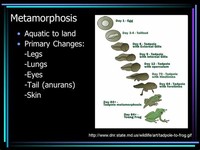
Eyes migrate rostrally and dorsally, allowing for binocular vision exhibited by the adult frog.

Eighteenth-century biologist Luigi Galvani discovered the link between electricity and the nervous system through studying frogs.

Certain frogs change color between night and day, as light and moisture stimulate the pigment cells and cause them to expand or contract.

Once at the breeding ground, male frogs call to attract a mate, collectively becoming a chorus of frogs.

Overall, about 88 percent of amphibian species are frogs, with the order Anura containing 5,250 species in 33 families, of which the Leptodactylidae (1100 spp.

Frogs are known for their three-chambered heart, which they share with all tetrapods except birds and mammals.
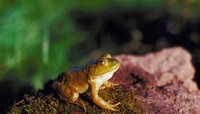
When a frog is underwater, oxygen is transmitted through the skin directly into the bloodstream.

Frogs are used as a food source; frog legs are a delicacy in China, France, the Philippines, the north of Greece, and in many parts of the Southern United States, especially Louisiana.

Frogs are the most numerous and diverse amphibians, being found in nearly all habitats, including arboreal, aquatic, and terrestrial niches, and every continent except Antarctica.

When the frog applies pressure to the toe pads, the interlocking cells grip irregularities on the substrate.

The Neobatrachians comprise what is considered the most modern species of frog.

Some frogs lack vocal sacs, such as those from the genera Heleioporus and Neobatrachus, but these species can still produce a loud call.

Many characteristics are not shared by all of the approximately 5,250 described frog species.

Some species of poison dart frogs lay eggs on the forest floor and protect them, guarding the eggs from predation and keeping them moist.

The eggs are highly vulnerable to predation, so frogs have evolved many techniques to ensure the survival of the next generation.

At the end of the tadpole stage, frogs undergo metamorphosis, in which they transition into adult form.

The chemical makeup of toxins in frogs varies from irritants to hallucinogens, convulsants, nerve poisons, and vasoconstrictors.

Frogs are most noticeable by their call, which can be widely heard during the night or day, mainly in their mating season.

The Frog Prince is a fairy tale of a frog who turns into a handsome prince once kissed.

The African clawed frog or platanna (Xenopus laevis) was first widely used in laboratories in pregnancy assays in the first half of the twentieth century.

A female generally lays frogspawn, or egg masses containing thousands of eggs, in water.

Some frogs obtain poisons from the ants and other arthropods they eat (Saporito et al.
FrogFrogs Temporal range: Early Jurassic - Present, 200–0 Ma PreЄ Є O S D C P T J K Pg NPhylum:ChordataClass:AmphibiaClade:SalientiaOrder:Anura Duméril, 1806 (as Anoures)8 more rows
Frogs do not have external ears like us. However, they do have eardrums and an inner ear. The frog ear is called a tympanum and is the circle you see behind a frog's eye. Some frogs have small tympanums, while others have ones that are larger than their eyes.Oct 22, 2015
The female tailed frogs then lay their fertilized eggs underneath rocks in streams. Some other frogs that have internal fertilization give birth to miniature frogs, or "froglets." But L. larvaepartus is the only species known to give birth to live tadpoles, the researchers said.Dec 31, 2014
They have a small sac in their throats that vibrates the air as they slowly let it out. The sounds that frogs make are not what you'd expect. Did you know that there are frogs that chirp? Others can whistle, croak, ribbit, peep, cluck, bark and grunt.
Frogs and toads are carnivores, which means that they will eat meat. Small to medium sized frogs eat insects such as flies, mosquitoes, moths and dragonflies. Larger frogs will eat larger insects like grasshoppers and worms. Some large frogs will even eat small snakes, mice, baby turtles, and even other smaller frogs!
In the early movie days, when Hollywood needed sounds for a night scene, they took their microphones outside the studio. That's how the world was introduced to that famous RIBBIT frog sound. It's the Pacific treefrog (Hyla regilla).
They still breathe air, but they typically hold their breath anywhere between 4 and 7 hours! The frog though, well, almost all frogs and toads are capable of breathing under water. They do this by absorbing oxygen through their skin.Feb 8, 2016
A. Most frogs and toads breathe (and take in moisture) through their skin through a process called cutaneous gas exchange, but they also have lungs with which they breathe. During the time they stay submerged under water or buried in soil (such as during hibernation) they ONLY breathe through their skin.
Bullfrogs and green frogs, although they have lungs and breathe air, spend almost all their adult lives in the water. On the other end of the spectrum, toads and treefrogs spend the majority of their adulthood outside of water. All frogs and toads, however, must eventually come back to the water to mate and lay eggs.Aug 10, 2001
While Jim Henson did have a childhood acquaintance named Kermit, it was not an uncommon name at the time, and Jim always said that the Frog was NOT named after this child from his elementary school.
The earliest version of Kermit first appeared in 1955 on Sam and Friends, Jim Henson's five-minute puppet show that aired twice daily on WRC-TV. The soon-to-be-famous frog had humble origins, as Henson explained in 1977: "I'd paint the scenery, and Janie would carry it in the station wagon.
A new frog species from Costa Rica is the spitting image of the beloved Kermit the Frog. The inch-long (2.5 cm) amphibian, named Hyalinobatrachium dianae, joins Costa Rica's 13 other types of glass frogs, creatures named for their translucent bodies, Live Science reported earlier this month.May 1, 2015
Hyalinobatrachium dianae, also known as Diane's bare-hearted glass frog, (or a Kermit frog due to its peculiar appearance) is a species of Costa Rican glass frog in the family Centrolenidae.
(CNN) Hi-ho, Kermit the Frog has some competition. A newly discovered species of glassfrog looks an awful lot like the famous Muppet. Bulging white eyes, Kelly green skin, the works. But the name's not nearly so catchy as its famous counterpart: Hyalinobatrachium dianae, or Diane's bare-hearted glassfrog.Apr 21, 2015



